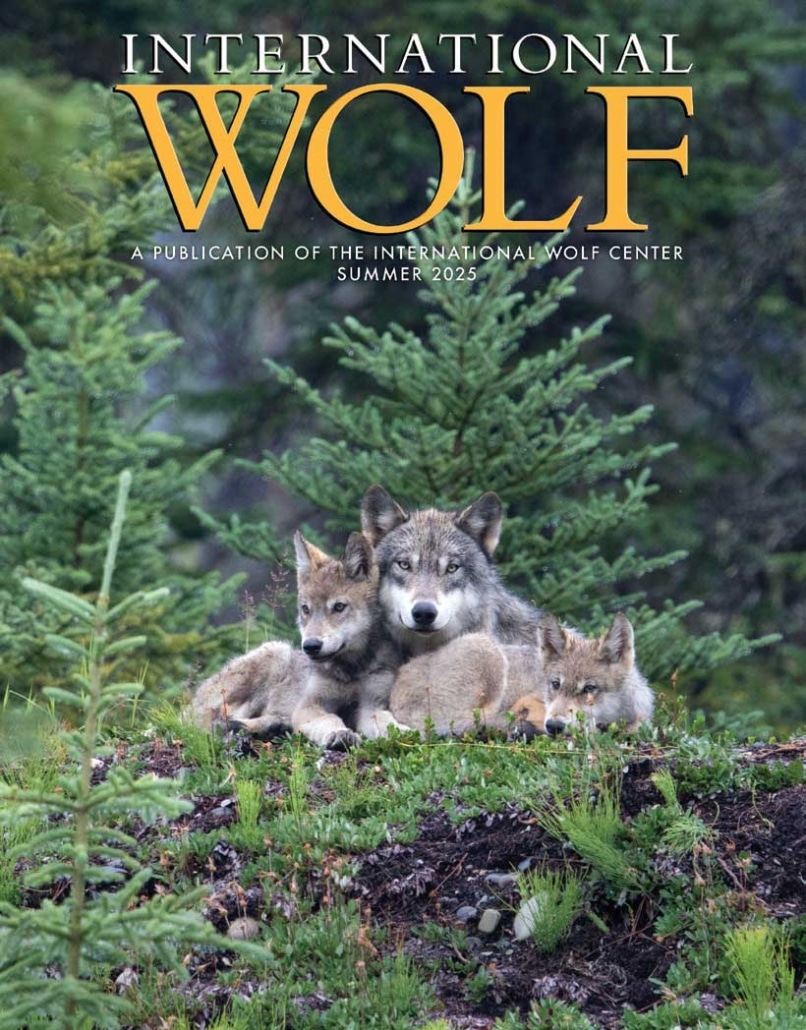International Wolf is our quarterly magazine where we share all aspects of the wolf story, from ranchers’ concerns to the spiritual thrill of meeting a wolf in the wild. Many of the world’s leading wolf biologists share their writing talents with us for in-depth articles.
Save
Become a member of the International Wolf Center today to receive your quarterly subscription and enjoy many other benefits! Membership is the only way to receive every issue promptly upon release!
Magazines arrive in mid-February, mid-May, mid-August, and mid-November.
Summer 2025
Features
Gray wolves, white bears
By Jad Davenport
A citizen-science study on Manitoba’s Kaskattama Coast explores interactions between gray wolves and polar bears. Wolves, known for preying on polar bear cubs, share this unique biome where forest, tundra, and sea meet. Led by Jad Davenport, the research team—comprising guides, guests, and First Nations hunters—tracks wolves, documents encounters, and gathers oral histories. Their efforts reveal a complex coexistence between these apex predators, advancing understanding through non-invasive methods.
California’s gray wolves continue their comeback
By Kevin Harter
California’s gray wolf population has grown to seven packs with about 50 wolves, including 35 pups born in 2024. Their return, hailed as an ecosystem success, follows protections under the Endangered Species Act. The California Wolf Project aims to balance conservation with ranchers’ concerns over livestock predation. Scientists and stakeholders are collaborating to address ecological and social challenges while shaping the future of wolf management in the state.
Mythical vs. real wolves: Insights from Flying D Ranch
By Mike Phillips
Wolf recovery faces challenges rooted in myths portraying wolves as destructive predators. Research led by Val Asher at Flying D Ranch in Montana dispels these myths, showing wolves have minimal impact on livestock and big game. From 2009 to 2024, Asher’s studies documented the Beartrap Pack’s resilience and coexistence with humans. Her findings affirm that private lands like the Flying D can support wolf conservation while maintaining ecological balance and economic viability.
Departments
From the Executive Director
Celebrating 40 years of science-based wolf education
by Grant Spickelmier
Forty years ago, on June 27, 1985, a group of 11 men and women came together at the request of Dr. L. David Mech and officially incorporated a “Committee for an International Wolf Center.” Originally tasked to develop a permanent home for the traveling “Wolves and Humans” museum exhibit (which anchored our fabulous visitor center in Ely, Minnesota), the International Wolf Center has evolved over the last four decades, and has remained committed to science-based education about wolves.
In one sense, the world of wolves has changed dramatically since our organization’s founding. In 1985, gray wolves only lived in a few places in the United States and reintroductions into Yellowstone National Park and Idaho were still a decade off. Our understanding of wild wolf behavior was limited to mostly winter observations of radio-collared wolves from airplanes or captive studies. In the rest of the world, wolf populations were even less well understood.
Tracking the Pack
Seasonal Fluctuations
By Giselle M . Narváez Rivera
One of the most common questions asked by visitors to the International Wolf Center is “what is the weight of the ambassador wolves?” We reply with the most current weight of each wolf ambassador, and that is usually enough to satisfy their curiosity. While this seems like a simple question with a straightforward answer, it is more complicated than it seems.
Wolves of World
By Denise Hughett
TEXAS
Colossal Biosciences, a Texas-based biotechnology company, has announced the birth of four cloned Red “ghost” wolves, aiming to bolster the genetic diversity of the American red wolf, a critically endangered species. With fewer than 20 red wolves remaining in the wild, primarily in North Carolina, the species faces an uncertain future. Red “ghost” wolves carry substantial red wolf genetic ancestry, with these clones carrying approximately 70% of red wolf ancestry. Colossal and their collaborative researchers of the Gulf Coast Canine Project are investigating ways in which these “ghost alleles,” genetic traits from historical and extinct wild red wolf populations, could enhance the genetic resilience of the American red wolf.
BELGIUM
The population of wolves in Belgium is estimated to be approximately 20 individuals. In 2024, no wolves were born in Flanders, and in Wallonia, only 11 pups were born. A wildlife organization (Welkom Wolf) states that the region is suitable for wolves, and the low population levels are cause to implement protection measures. A request to build a traffic mitigant (for example, a wildlife corridor) is being met with resistance. The local government, while sympathetic, states that its priorities lie elsewhere.
CANADA
Measures to protect the rare eastern wolf were recently put into place. The taxonomic status of the eastern wolf is still controversial, with some scientists considering it a subspecies of the gray wolf. In July 2024, the federal government upgraded the status of the eastern wolf from “a species of special concern” to “threatened.” Furthermore, the federal government has stated that work on a recovery strategy is underway. However, the implementation of protection measures is presenting a challenge across the provinces of Canada. For example, Quebec’s Environmental Department does not believe the eastern wolf is a separate and distinct species from the gray wolf. This view results in the Quebec government believing that the eastern wolf does not need protection. In October, Quebec launched an effort to gain insight into to the populations of large canids in the area. However, this effort has proved to be difficult due to the small population and the level of hybridization occurring in wild canids. This stance contradicts the federal government’s view which is premised on genetic analyses that suggest that the eastern wolf is a distinct species.
GREECE
Wolves have returned to Mount Taygetus, which is near ancient Sparta. Camera traps captured images of nine wolves. This is the first scientific evidence of wolves in the region since the 1930s. While wolves have been observed in areas of mainland Greece, their appearance in the Peloponnese (a peninsula off the mainland), is an important step in wolf recovery. It is believed that around 700 wolves populate Greece. They are usually found in the remote mountainous areas of the country.
PORTUGAL
The Portugese government is requiring a plan to preserve the country’s population of Iberian wolves. This action is based on concerns that the population is decreasing. Past censuses (2019 and 2021) reflect a 20% decrease in wolf range in Portugal. Furthermore, the number of packs has also decreased to 58, an 8% drop. The main causes for the decreases are hunting of wolves, roadkills, and responses to livestock depredations. A lower tolerance to wolves, low prey populations, and the construction of infrastructure to support energy and communication needs are all impacting wolf conservation.
EUROPE
The Council of Europe’s Bern Conven-tion Committee, an international group for nature conservation, voted in December 2024 in favor of the European Union proposal to modify the listing of the wolf from Appendix II of “strictly protected” to Appendix III of “protected” fauna species. For wolves, the “strictly protected” status prohibits all forms of disturbance, capture and keeping and the deliberate killing of the species, particularly during its breeding and pup rearing season. It also prohibits any kind of damage or destruction to their breeding and resting sites. Lowering the degree of protection relaxes these prohibitions and allows for a certain level of “exploitation.” Yet, as “protected” species under Appendix III any “exploitation” needs to be carefully regulated, because this may open the way for European countries in the Convention to establish wolf hunting seasons. Under their previous status, culling was acceptable as a last resort only under certain circumstances, such as preventing serious damage to livestock or the health and safety of the public.
SWEDEN
In January, Sweden began its annual wolf hunt with a quota of 30 wolves to be culled. Wolves were extirpated from the Swedish landscape in the 1960s but dispersed from neighboring countries and slowly recolonized it in the 1980s. The current wolf population is estimated at 375 individuals, a 20% decrease from 2022-2023. This sharp decrease is largely due to hunting and government efforts to reach a “favorable conservation status” with a new minimum of 170 wolves.
Personal Encounter
Living for That Moment
By Douglas W. Smith
I can’t remember why I became interested in wolves. I grew up in nature, on a camp in Ohio that my dad owned and operated, but that was certainly a long way from any wolf. Nature isn’t necessarily wild, especially Ohio, but to my thinking wolves were wild, quintessentially so, and in my moments alone in the woods and fields of my dad’s camp, I conjured the image that I was in the wilds like the wolves. Oh, how unlimited the imagination of youth can be!
A Look Beyond
Mexican Wolf Recovery Sees Success with Foster Effort
By Aislinn Maestas
In 2024, the U.S. Fish and Wildlife Service (USFWS) and its partners fostered a record 27 Mexican wolf pups into wild dens. Now entering its 10th year, the effort is helping to improve the genetic diversity of the wild population of Mexican wolves and, in turn, bringing the subspecies closer to recovery.

The International Wolf Center uses science-based education to teach and inspire the world about wolves, their ecology, and the wolf-human relationship.

